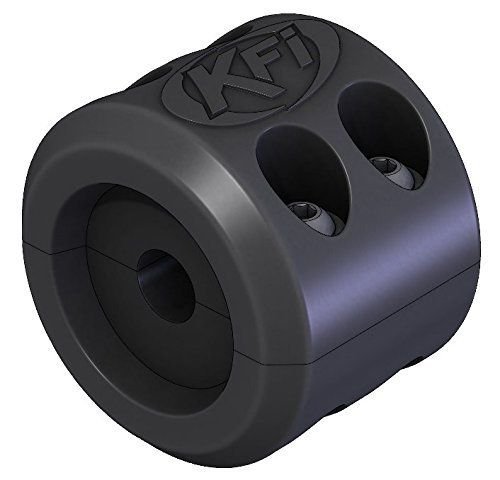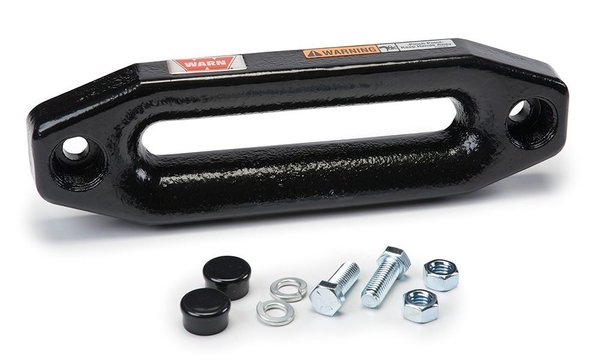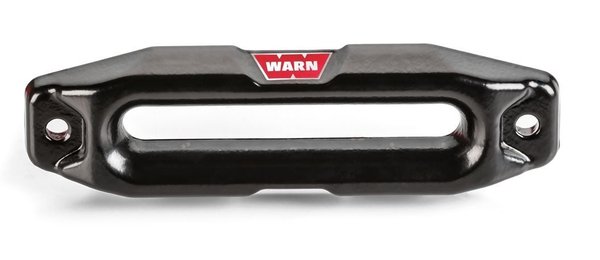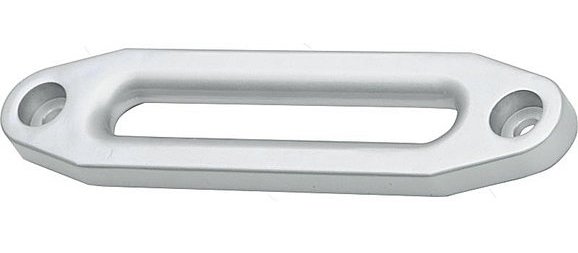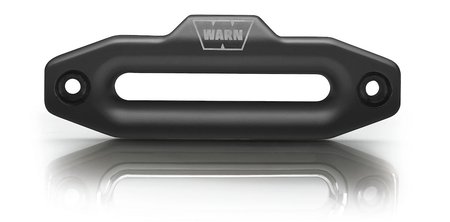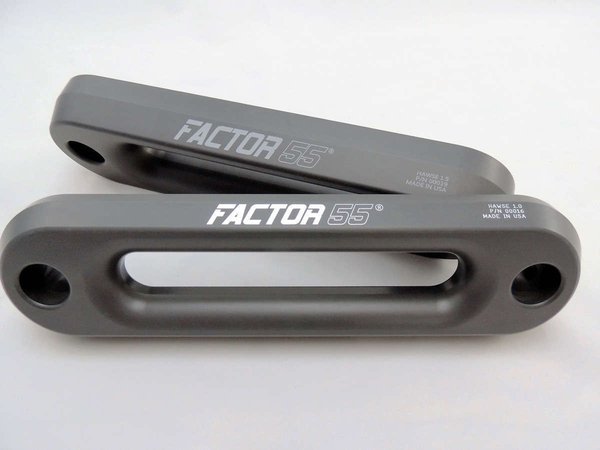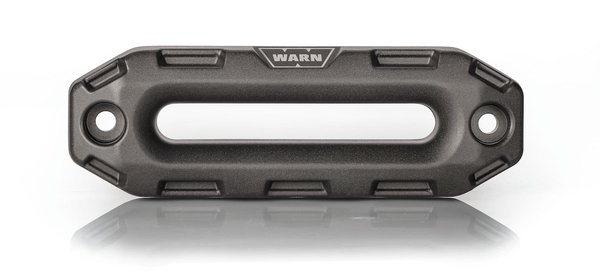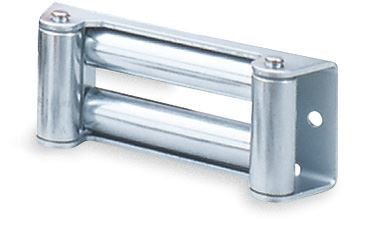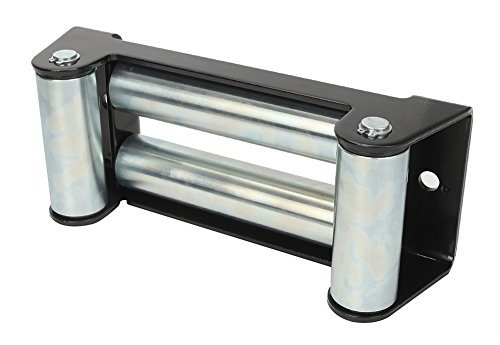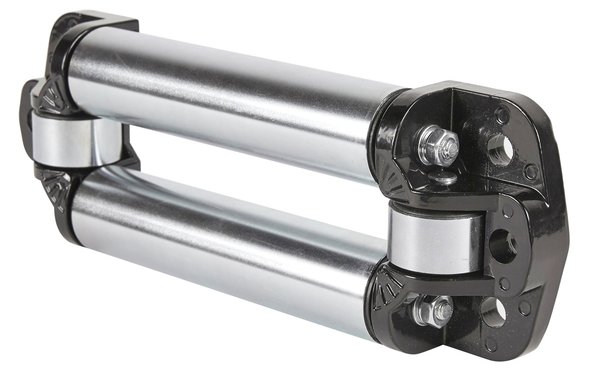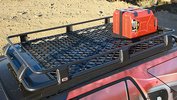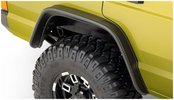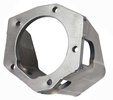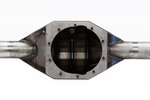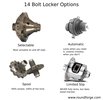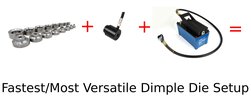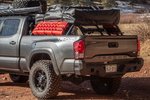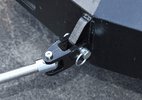Winch Fairleads: How to Pick the Best One
There are way many more winch fairleads out there than it seems there should be! It's this confusing mass of parts and configurations when all you want is a smooth-feeding winch line.
But:
It doesn't have to be so complicated.
We're going to break down the differences between hawse and roller fairleads, steel and aluminum fairleads, help you pick the right size, and tell you what to get for winches with steel cable or synthetic winch rope.
- Aluminum Vs. Steel Fairleads: Materials Matter
- Hawse Fairleads Vs. Roller Fairleads
- Fairlead Finishes
- Fairlead Mounting
- Steel Hawse Fairleads - FOR STEEL CABLE AND SYNTHETIC WINCH LINE
- Aluminum Hawse Fairleads - SYNTHETIC WINCH LINE ONLY
- Steel Roller Fairleads - FOR STEEL CABLE AND SYNTHETIC WINCH LINE
- Winch License Plate Mounts for Staying Legal
- The Winch Recovery Kit Comparison Guide
- Roller Fairleads vs. Hawse Fairleads: The Differences
- They'd have the stickout of a typical roller fairlead
- And the softness of aluminum
- It's lighter than steel winch cable.
- It's less likely to be dangerous if it breaks.
- It's stronger than steel winch cable.
- Want a lighter, safer, stronger winch line setup: Run an aluminum fairlead with synthetic winch rope
- Want a more durable winch line setup: Run a steel roller fairlead with steel winch cable
- most winches mount on a 10" x 4.5" pattern
- 4x4 fairleads mount on a 10" pattern
- It's a little thin - a thicker hawse means less stress on your winch rope. It's like airing down your tires.
- According to Smittybilt, these are billet. However, some units have casting bubbles in them...so...maybe not the best billet.
- It's polished. If you use this thing a lot, it's going to look terrible after some rope has run through it and it's gotten wet.
- They come in 1" and 1.5" thicknesses. Thicker is often better - they can machine in a larger chamfer more extreme rope winch angles are possible.
- They use a Type III anodized coating, which is the best coating you can get for a fairlead.
- The rope slot is 1.25" thick. This is a big deal since most slots are 3/4" thick. With their fairlead you can fit a 1/2" thimble.
- Polished aluminum
- Type III anodized black
- Type III anodized gunmetal
Aluminum Vs. Steel Fairleads: Materials Matter
One of the first things you'll notice is that fairleads come in two materials: steel or aluminum.
You should remember is that steel is hard and aluminum is soft. With steel winch cable you absolutely need to use a steel fairlead.
Since steel is harder than aluminum, a steel winch cable will chew up a standard aluminum fairlead. This means you'll be using either a steel roller fairlead or a steel hawse fairlead with steel cable.
You can still use synthetic winch rope with a steel fairlead, but more on that below.
Aluminum fairleads are only used with synthetic winch rope.
To sum up:
Steel roller and hawse fairleads can be used with steel winch cable or synthetic winch rope.
Aluminum hawse fairleads can be used with synthetic winch rope.
What about aluminum roller fairleads?
While we've seen them on the Internet, we don't know of anyone that actually sells these.
In any case:
They probably wouldn't be great for fourwheeling:
You could probably only use them with synthetic winch rope.
What About the composite Daystar winch rollers?
Forget them!
If you don't know, Daystar makes replacement winch rollers to replace the rollers on your roller fairlead.
They are well-known to be too soft and get chewed up too quickly.
Viking used to make some harder plastic rollers...but now they don't.
Hawse Fairleads Vs. Roller Fairleads
We see tons of questions about whether you should be using a hawse or roller fairlead. Here are the differences:
Hawse Fairleads - WINCH LINE SLIDES
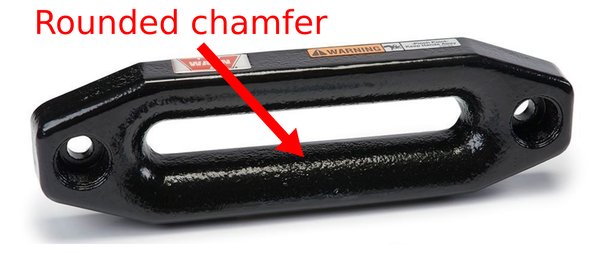
The chamfer on a steel or aluminum hawse allows steel winch cable or synthetic winch rope to slide over it easily. The bigger the chamfer and the thicker the hawse, the easier it is on the cable or rope.
Hawse fairleads are made from one piece of cast iron or machined aluminum. They have no moving parts, are extremely simple and basically won't break under normal use.
Winch cable and synthetic rope slide (or grind if you make the mistake of using steel cable with an aluminum hawse!) on hawse fairleads.
Since hawse fairleads are fairly small and have little material, they're always lighter than a roller fairlead. A typical aluminum hawse weighs around 2 lbs.
While it isn't much alone, switching to an aluminum fairlead with synthetic winch rope can drop about 40 lbs. off the weight of the typical winch!
That might not sound like a lot, but it makes a difference when you're moving/mounting the winch and is a huge help if you're on a quest to lighten your rig.
Another great quality of hawse fairleads is that they stick out less than a steel roller fairlead - usually about 1" at the most. For some people this is a matter of appearance, but we do like the fact that a thinner fairlead won't be bashing on rocks.
The steel on steel contact of a steel winch cable and steel hawse is okay, but the vast majority of wheelers run a roller fairlead with steel cable.
Roller Fairleads - WINCH LINE ROLLS
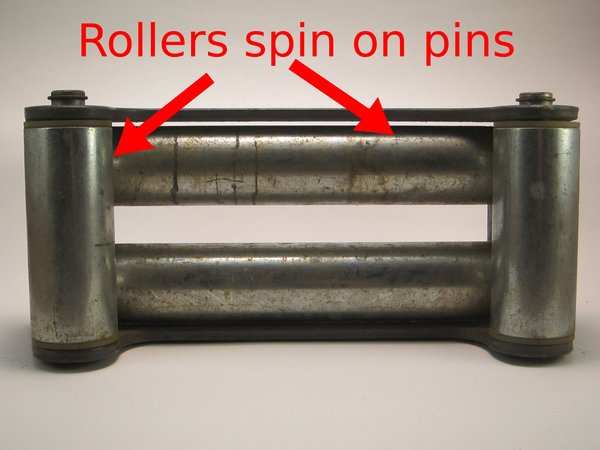
Since rollers spin, there is less friction with a roller fairlead. But they are heavier, stick out more, and can jam in extreme side pulls. They are still a very solid choice for your winch.
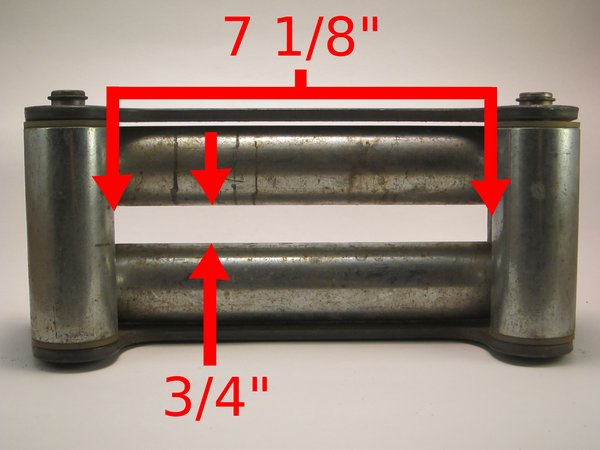
Most roller fairleads have a standard 3/4" x 7 1/8" opening. This can be problematic (too small) with some aftermarket hooks and large rope thimbles.
Roller fairleads for fourwheeling are configured with 2 horizontal and 2 vertical rollers that spin on bushings inside the rollers.
Almost every steel-cabled winch you buy today will come with a steel roller fairlead. In fact, it's probably hard to find a retailer that sells a steel-cabled, steel hawse winch anymore.
Rollers were the standard for winches for years and years, but we're seeing more and more winches produced with aluminum hawse.
We don't see a lot of failure of the rollers - they don't spin at high speeds and the pins are pretty difficult to bend.
Steel roller fairleads generally weigh around 11.5 pounds and stick out 3.5-4" from the fairlead mounting surface. This is quite a bit heavier and larger than a typical hawse.
Which one is better?

Most roller fairleads have a standard 3/4" x 7 1/8" opening. This can be problematic (too small) with some aftermarket hooks and large rope thimbles.
Well, neither - it just depends on what you want to do.
Historically,
you could often get a winch with a steel hawse fairlead for cheaper
than a winch with a roller fairlead. So for years, the cheaper winches
were the ones with the steel hawse.
If you had a steel hawse, a roller fairlead was a common upgrade to make your winch cable glide a little better.
But now:
Things have changed and synthetic winch rope is becoming the thing to use on your winch. This is not without reason:
From the manufactures' perspective, synthetic winch rope and and aluminum hawse fairleads are proving to be a good, long-lasting combo.
Plus:
A roller fairlead has a ton of moving parts (probably 25-35 individual pieces!) and assembly - bushings, rollers, pins or bolts, circlips or nuts, and a bent steel frame to hold it all.
An aluminum hawse fairlead is just a chunk of machined aluminum that a computerized mill can make.
It wouldn't be surprising if these fancy aluminum fairleads have pretty decent profit margins on them....
All that said, if you:
As a final note, there's always lots of debate on forums about synthetic winch rope vs. steel winch cable. While we still run some steel cable on some of our winches, it makes sense to upgrade to synthetic unless you have a very specific use case for steel.
Can I use a roller fairlead with synthetic winch rope?
Yes, but keep reading.
This is probably one of the most commonly asked question about fairleads.
First, let's point out that virtually every synthetic winch line manufacturer recommends using an aluminum hawse fairlead.
Why?
Most people that are buying synthetic winch rope are retrofitting it to a winch that already has steel winch cable. If you've used your winch a lot, take a look at the rollers.
Heavily used winches will have burrs and nicks on the roller surface. If you want to use your old roller fairlead with your new synthetic winch rope, just file and sand the burrs (careful about removing the galvanizing) and make sure the surface is smooth.
You simply want to prevent the damage on the winch rollers from destroying your new rope.
That's it.
Some winch rope manufacturers also say that synthetic winch rope can get pinched between the rollers in a roller fairlead.
However, virtually no one reports this being a problem, so we don't think you should worry about.
Fairlead Finishes
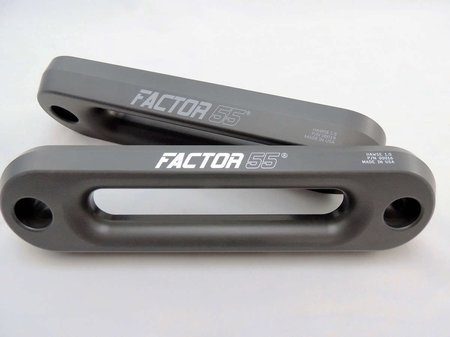
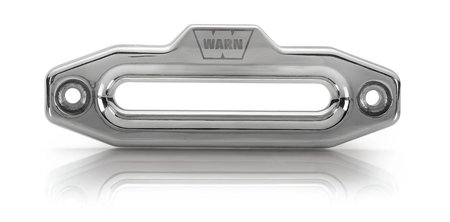
This is the hardest coating you can get on an aluminum hawse. It's low-friction, and low-wearing.
It's pretty, but grit embedded in a synthetic winch rope is like sandpaper on polished aluminum.
There are a few finishes for winch fairleads and they aren't equivalent.
Polished aluminum: Essentially, this means no finish.
Galvanized: This is the finish on roller fairlead rollers. This may wear off after a long time and start to rust, but our oldest Warn rollers are still in very good shape.
Powdercoat: You'll see this on steel hawse fairleads. It'll eventually wear down with steel winch cable use and need to be painted. With enough winch use, you'll can wear this down using a synthetic winch rope as well.
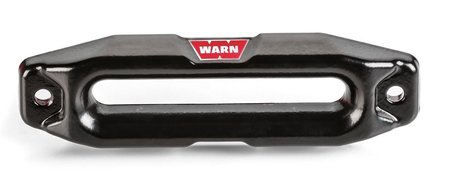
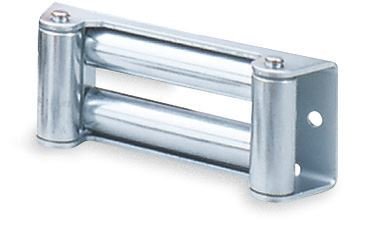
Expect powdercoat with a steel (cast iron) hawse. The powdercoat will wear away and need some spraybomb touchup.
Most roller fairleads have galvanized rollers and a painted frame.
Type II anodizing: Basically a cosmetic anodizing to make a fairlead have a pretty color.
Type III anodizing: This is an extremely hard finish (close to diamond hardness!) with high durability and low friction.
With steel roller fairleads, you generally don't have a lot of choices. Most fairleads that are reasonably priced have galvanized rollers with a gray or black frame.
Steel or cast iron hawse fairleads are either going to be powdercoated or painted.
Aluminum fairleads are available in polished/raw aluminum, powdercoated, Type II, Type III anodized coatings.
Plan to winch a lot with a synthetic rope and aluminum hawse?
Go with a Type III coating. Your winch rope and hawse will last longer.
Fairlead Mounting
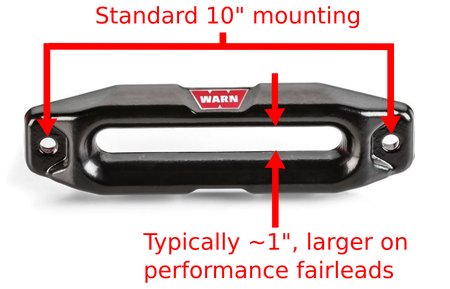
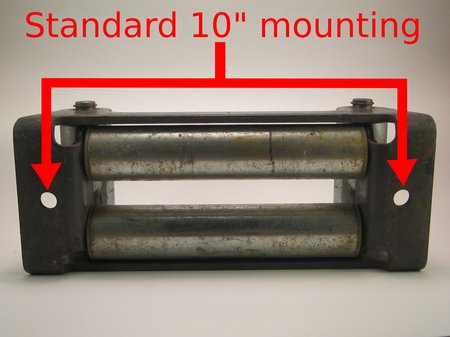
Almost all 4x4 hawse fairleads will have a standardized mounting of two holes on 10" centers. The center opening will vary with the manufacturer. Some larger synthetic rope thimbles may require a larger opening, like that on a Factor 55 hawse.
Almost all 4x4 roller fairleads will have a standardized mounting of two holes on 10" centers.
Winch fairleads mount in a couple of different ways, but first, let's talk about dimensions.
Winch fairleads, both hawse and roller, are universally mounted with 2 bolts, spaced 10" apart.
The 10" spacing is universal, so if you buy a roller or hawse fairlead for a 4x4, it'll (almost always!) have these dimensions and bolt up to your winch.
Note that Smittybilt bucked the trend and sells a 4x4 "slim" fairlead with non-standard 11" spacing. There are also "industrial" fairleads that come in wide-spaced configurations.
Basically:
You can buy any (almost) fairlead that's intended for a 4x4 winch and it'll bolt up to your winch and/or winch bumper.
Hardware
Almost all 4x4 winch fairleads mount with two bolts. Usually these are 3/8", 7/16" or 10mm spaced at 10" apart on center.
Do not expect hardware to come with a fairlead! They almost never include hardware. Use the largest size bolt that'll fit your mounting.
For a foot-forward configuration, your bolts will likely need to fit: the fairlead, bumper, and the threads in the winch body. Chinese-made winches like Smittybilt usually have 10mm through holes. US-made winches like Warn usually have 3/8" or 7/16" coarse threaded holes.
For a foot-down configuration, your bolts need to be long enough to go through the fairlead and your bumper or fairlead mount.
What grade bolts?
We always recommend the highest grade you can reasonably get, so:
For metric: Grade 10.9
For imperial: Grade 8
Protect Your Fairlead and Your Winch Line
A hook stopper keeps your winch hook out of your winch's roller or hawse fairlead.
One of the handy little products that's come out recently is the winch stopper.
What it stops:
Sometimes you get overzealous and reel in your winch line a little too much.
You want your winch line to be tight, right?
But this can suck your winch hook in and damage your fairlead or winch line.
We don't see as much of a need for this product with steel winch cable or roller fairleads, but it's a good way to prevent your steel winch hook from nicking your aluminum fairlead or crushing your synthetic winch rope.
Mounting Tips
It always looks like your fairlead mounts directly to the winch in promo pictures, but this isn't really the case.
Most winch mount spacing and winch fairlead spacing are the same:
In a foot-forward configuration, your fairlead may use the mount holes in the winch, but the winch and fairlead will sandwich some sort of winch mounting plate.
In a foot-down configuration, the winch will sit slightly back from the fairlead mounting plate. The fairlead will use its own hardware to mount to the plate.
If you have a winch bumper that mounts your winch foot-down, make sure to install the fairlead first - it can be a little tight to reach the fairlead mounting bolts otherwise.
Where does your license plate go?
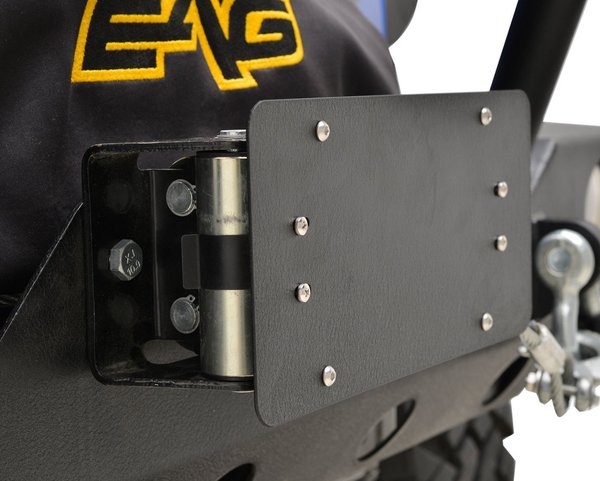
The mount plate is made of steel and has a textured powdercoat finish.
If you live in a state or country that requires license plates on the front and back of your vehicles, you need to stick the plate somewhere.
Fortunately, there are flip-down license plate mounts, and plate mounts specifically for hawse fairleads.
If you want to see more we wrote all about winch license plate mounts.
What about those tiny fairleads?
Roller and hawse fairleads for ATVs and side-by-sides are smaller and have smaller spacing. They mount with holes at 4 7/8" or 6" apart on center.
These fairleads will not fit your 4x4 winch!
Besides the fairlead mount spacing, the winch line opening is too narrow to allow winch line to properly spool on to the winch drum.
Steel Hawse Fairleads - FOR STEEL CABLE AND SYNTHETIC WINCH LINE
The Standard Warn Steel Hawse - NO MOVING PARTS
| Part number | 73850 |
|---|---|
| Material | Cast iron |
| Finish | Powdercoat |
| Works with steel winch cable | Yes |
| Works with synthetic winch rope | Yes |
| Mounting distance | 10" |
| Hardware included? | Yes |
| Thickness | 1 3/16" |
This is Warn's standard hawse fairlead. If you buy a winch with a steel hawse, you'll most likely get this hawse.
This hawse is actually cast iron, not steel. It comes with a powdercoat finish which is fine to use with steel or synthetic winch lines.
Remember that using this hawse with steel winch cables will eventually cause the powdercoat to wear away and make it rust. You'll probably want to paint it once or twice a year.
One thing to pay attention to:
This fairlead had some quality control issues a few years ago where some units came with a raised parting line from the casting process.
The parting line was on the mounting surface which, of course, made it impossible to mount without grinding down the casting artifact.
So:
If you pick one of these up, make sure you check that the mounting surface is flat enough to mount it.
Warn Steel Hawse Fairlead - FANCIER
| Part number | 97900 |
|---|---|
| Material | Cast iron |
| Finish | Powdercoat |
| Works with steel winch cable | Yes |
| Works with synthetic winch rope | Yes |
| Mounting distance | 10" |
| Hardware included? | Yes |
| Thickness | 1 3/16" |
This is another cast iron hawse fairlead from Warn. Like the one above it is powdercoated and mounts on 10" centers.
These two fairleads aren't really very different except in styling. This is not a "standard" Warn, but actually comes on their Chinese-made VR series of winches.
Of course, that means this hawse is also made in China, but so is the one above!
Aluminum Hawse Fairleads - SYNTHETIC WINCH LINE ONLY
Smittybilt Aluminum Hawse Fairlead - BUDGET
| Part number | 2809 |
|---|---|
| Material | Aluminum |
| Finish | Polished |
| Works with steel winch cable | No |
| Works with synthetic winch rope | Yes |
| Mounting distance | 10" |
| Hardware included? | Yes |
| Thickness | 3/4" |
This hawse is definitely a budget version! While we appreciate it's simplicity, it's definitely lacking features that other hawse fairleads have.
Here are the cons:
It's an okay choice if you need a cheap hawse, but be forewarned.
Warn Premium Aluminum Hawse Fairlead - DECENT
In Warn's Premium line, this fairlead will hold up to gritty synthetic lines grinding over it better than the polished version. Synthetic winch rope only.
These fairleads mostly have different styling from the Epic line from Warn, and come in both polished and Type III anodized. They're only available in 1" thickness. Synthetic winch rope only.
| Part number | 100333, 100334 |
|---|---|
| Material | Aluminum |
| Finish | Type III Anodized Black or Polished |
| Works with steel winch cable | No |
| Works with synthetic winch rope | Yes |
| Mounting distance | 10" |
| Hardware included? | No |
| Thickness | 1" |
These fairleads are both from Warn's Premium line. They're both aluminum and suitable for synthetic winch rope.
Each is machined from forged 6061-T6 billet aluminum and we expect these will be normal Warn quality. They are 1" thick.
Which one should you choose? If you read the finishes section, you'll know that we'd choose the black every time. It has the Type III anodizing that'll keep the fairlead and winch rope lasting long.
If you like prettier things, grab the polished aluminum, just know that it won't hold up as well. We won't jusge you too much....
Factor 55 Aluminum Hawse Fairleads - BEST
| Part number | 00016, 00019 |
|---|---|
| Material | Aluminum |
| Finish | Type III Anodized Gray |
| Works with steel winch cable | No |
| Works with synthetic winch rope | Yes |
| Mounting distance | 10" |
| Hardware included? | No |
| Thickness | 1" or 1.5" |
So Factor 55 came along and really made a name for themselves with the winch parts they're making. They're a small company that makes decisions based on what we wheelers are doing. Of course, you have to pay for that!
Some of the fancy features of these fairleads are:
If you're running synthetic:
This is the type of fairlead that almost anyone will be happy with.
Warn Epic Aluminum Hawse Fairleads - BEST
| Part numbers, 1" | 100655, 100650, 100660 |
|---|---|
| Part numbers, 1.5" | 100730, 100725, 100735 |
| Material | Aluminum |
| Finish | Type III Anodized Black, Gunmetal, or Polished |
| Works with steel winch cable | No |
| Works with synthetic winch rope | Yes |
| Mounting distance | 10" |
| Hardware included? | Yes |
| Thickness | 1" or 1.5" |
The Epic fairleads go along with the rest of Warn's Epic line of winch products, like their winch hooks and recovery kits.
We think they might have been trying to catch up to the manufacturers that are making thick aluminum fairleads with Type III anodized finishes, as these came out later than fairleads from companies like Factor 55.
In any case, the Epic line comes in 1" and 1.5" thicknesses.
There are three finishes available:
Again, if your winch is going to see real, serious use we recommend against the polished aluminum. It won't hold up as well to the grit grinding that your winch rope is going to subject it to.
Steel Roller Fairleads - FOR STEEL CABLE AND SYNTHETIC WINCH LINE
Warn Roller Fairlead - THE STANDARD
| Part number | 5742, 69394 |
|---|---|
| Material | Steel |
| Finish | Zinc galvanized |
| Works with steel winch cable | Yes |
| Works with synthetic winch rope | Yes |
| Mounting distance | 10" |
| Hardware included? | No |
| Thickness | 3.5" |
These are the fairleads you get if you buy a new Warn winch. They are steal, they are heavy, and they stick out.
Of course, they are also time-tested! Chances are, if you buy an old Warn winch, the fairlead will still work just fine.
A couple things to note:
With these fairleads are that there are two "sizes" that work for different weight capacities:
The
WARN 5742 Roller Fairlead
5742 is for winches from 4,000 lbs. to probably 13,000 lbs. It does not fit the Warn M6000SDP. We say "probably" because Warn doesn't give an upper bound on the weight that this fairlead can handle. If you overload it, it's likely that you'll bend or jam a roller.The 69394 is listed as the fairlead for Warn's 15,000 lb. and 16,500 lb. winches, the M15000 and 16.5ti.
Since they have the standard 10" mounting, they'll fit other winches as well, not just Warn.
Standard Fairlead
Heavy Duty Fairlead
Auxmart Roller Fairlead - ROLLERS ON A BUDGET
| Part number | CECOMINOD098628 |
|---|---|
| Material | Steel |
| Finish | Zinc galvanized |
| Works with steel winch cable | Yes |
| Works with synthetic winch rope | Yes |
| Mounting distance | 10" |
| Hardware included? | No |
| Capacity | 8,000 - 17,500 lbs |
| Thickness | 3.5" |
For many wheelers, you can avoid paying the Warn "name tax" and pick up one of these roller fairleads instead.
You won't get the same quality as Warn, and many of the reviews out there are by customers that received this fairlead at a discount.
That said, for a moderately used winch, this fairlead is perfectly serviceable.
We don't think Auxmart really does a good job speccing out this fairlead - Warn's roller fairleads have a weight split. We suspect that quite a few of the budget manufacturers roll out products like this since extreme winch users are probably outliers.
As a result, budget manufacturers can put out products that "cover" a wider range of weight classes, but might realistically fail at a higher rate with extreme use or high weights. Food for thought....
Smittybilt Low Profile Roller Fairlead - TERRIBLE BUY!
| Part number | 2810 |
|---|---|
| Material | Steel |
| Finish | Zinc galvanized |
| Works with steel winch cable | Yes |
| Works with synthetic winch rope | No |
| Mounting distance | 2 bolt - 11" / 4 bolt - 10" x 2.5" |
| Thickness | 1.75" |
| Hardware included? | No |
This is an okay idea with terrible execution!
We know what Smittybilt was going for here, and it's awesome to see an attempt at innovation:
They wanted to create something that was lower friction than a hawse with a similar profile. At 1 3/4" thick, it's only 1/8" thicker than high end aluminum hawse fairleads.
Here are the problems:
Weird mounting: While every other fairlead mounts on 10" centers, this one mounts on either 11" centers or a 10" x 2.5" pattern. This is means redrilling your bumper, whereas every other fairlead just bolts on.
Pinching corners: We can't possible see how the corners (where the rollers meet) won't get messed up and/or cause binding on high angle pulls. Normal rollers have significant overlap to deal with this.
Not for synthetic rope: Because of the inside corner problem, you'll absolutely wreck synthetic rope on this thing.
While we're glad to see a new type of product in this space, we'll stick with our standard roller and hawse fairleads.
Last updated: September 5, 2019
